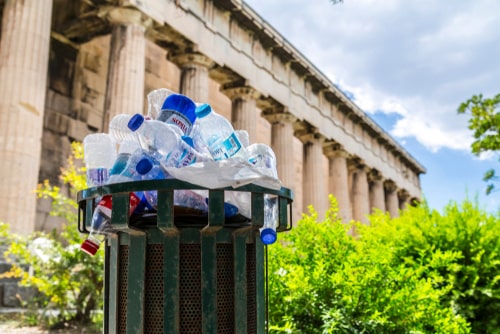When Did Recycling Start?
A Brief Journey
Recycling, a term deeply ingrained in our modern environmental consciousness, finds its roots in ancient civilizations. The practice of recycling resources has evolved over millennia, shaped by cultural, economic, and environmental factors. Exploring the history of recycling unveils a fascinating journey of human innovation and resourcefulness. So, when did recycling start? Let’s begin.
The Ancient Beginnings
The origins of recycling can be traced back thousands of years. Early societies, driven by necessity and a deep understanding of resource scarcity, engaged in primitive forms of recycling. When did recycling start? Evidence suggests that as far back as 400 BC, in ancient Athens, the concept of reusing materials like bronze for weaponry was prevalent. This practice reflects an early understanding of the value of repurposing materials rather than extracting new resources.
The ancient Athenians exhibited a remarkable understanding of resource conservation and reuse. Recycling in ancient Athens primarily revolved around materials crucial for their daily lives. Bronze, a vital metal for weaponry and household items, was a key focus of their recycling efforts.
Rather than extracting new ores, the Athenians employed a practice known as “chrysorrhoas,” melting down and recasting bronze objects. This process allowed them to repurpose existing bronze items, such as armor or utensils, into new forms. The Athenians’ pragmatic approach to recycling bronze not only conserved valuable resources but also showcased their ingenuity in maximizing the lifespan of materials essential to their society.
The First Society to Recycle
Determining the first society to recycle involves delving into the historical records of various civilizations. While pinpointing a singular society is challenging, ancient civilizations such as the Mesopotamians, Egyptians, and Romans demonstrated recycling practices. These societies recycled materials like metals, glass, and textiles, showcasing a resourceful mindset that prioritized sustainability and conservation.
The Mesopotamians, known for their innovative approaches to various aspects of civilization, displayed resourcefulness in their recycling practices, particularly with clay tablets. In ancient Mesopotamia, clay tablets were a primary medium for recording information. When scribes needed to update or correct inscriptions on these tablets, rather than discarding the entire tablet, they often reused the clay by smoothing its surface and imprinting new writings. This practice not only conserved the limited clay resources but also showcased their understanding of sustainability by maximizing the utility of existing materials.
The ancient Egyptians demonstrated a remarkable commitment to recycling, notably showcased in their approach to metalwork. Copper, a valuable metal in ancient Egypt, was extensively used for various purposes, including tools, jewelry, and religious artifacts. The Egyptians practiced metal recycling by collecting scrap metal from old tools, weapons, and other copper-based items. These scraps were melted down in furnaces, allowing craftsmen to cast new objects while minimizing the need for fresh copper extraction.
The ancient Athenians exhibited a remarkable understanding of resource conservation and reuse. Recycling in ancient Athens primarily revolved around materials crucial for their daily lives. Bronze, a vital metal for weaponry and household items, was a key focus of their recycling efforts.
Rather than extracting new ores, the Athenians employed a practice known as “chrysorrhoas,” melting down and recasting bronze objects. This process allowed them to repurpose existing bronze items, such as armor or utensils, into new forms. The Athenians’ pragmatic approach to recycling bronze not only conserved valuable resources but also showcased their ingenuity in maximizing the lifespan of materials essential to their society.
Medieval Europe and Recycling Traditions
When did recycling start during the middle ages? During the Middle Ages, Europe witnessed the emergence of recycling traditions shaped by economic factors and resource limitations. Materials like paper, cloth, and metal were recycled within local communities. The rag-and-bone trade, where individuals collected and sold scraps, thrived during this period. This era marks a significant stage in the development of recycling practices, albeit on a smaller scale compared to today’s global recycling initiatives.
Industrial Revolution and Recycling’s Evolution
The Industrial Revolution transformed societal norms and consumption patterns, leading to a surge in mass production and waste generation. While this period brought forth technological advancements, it also escalated environmental concerns. Efforts to recycle and reuse materials gained momentum as a response to the increasing volume of waste. Innovations in recycling technology emerged, facilitating the reprocessing of materials like paper, glass, and metal.
Paper recycling expanded as the demand for paper surged with the rise of printing and publishing industries. Rag-and-bone men scavenged for discarded paper, collecting waste from homes and businesses to be repurposed into new paper products. Industrial mills adopted processes to break down paper waste into pulp, enabling the production of recycled paper.
Similarly, the demand for glass intensified during this period, prompting the establishment of glass recycling facilities. Scrap glass from broken bottles and windows became valuable raw materials for glassmaking, leading to the development of more efficient melting and reshaping techniques. The Industrial Revolution marked a turning point in the scale and sophistication of paper and glass recycling, paving the way for more structured and mechanized recycling processes in subsequent eras.
Modern Recycling Movements
The 20th century witnessed a paradigm shift in attitudes towards recycling. Environmental awareness campaigns, propelled by alarming pollution levels and resource depletion, catalyzed the modern recycling movement. Governments, industries, and advocacy groups collaborated to establish recycling programs and initiatives. The late 20th century saw the rise of legislation promoting recycling, encouraging the public to participate in waste reduction and recycling efforts.
Modern recycling technology has reached impressive levels of sophistication, enabling the reclamation and processing of diverse materials with remarkable efficiency. Advanced sorting systems, such as optical scanners and eddy current separators, form the backbone of contemporary recycling facilities. These systems use cutting-edge sensors and AI-driven software to identify and segregate different materials, including plastics, metals, paper, and glass, at incredibly high speeds and accuracy. This technology ensures precise sorting, allowing for the effective recycling of materials that were previously challenging to separate, enhancing overall recycling rates and reducing contamination in recycled products.
Moreover, innovative recycling processes like chemical recycling and pyrolysis have revolutionized the treatment of complex and difficult-to-recycle materials. Chemical recycling methods break down plastics into their molecular components, enabling the creation of new, high-quality plastics without degradation. Pyrolysis involves heating organic materials in the absence of oxygen to produce fuels, gases, and valuable chemicals. These cutting-edge techniques not only reduce waste but also offer solutions for materials that were traditionally considered unrecyclable, marking a significant step forward in the quest for a circular economy and sustainable waste management practices.
When did recycling start?
The history of recycling is a testament to humanity’s adaptability and ingenuity in managing resources. From ancient civilizations’ pragmatic reuse of materials to modern-day global recycling initiatives, the journey of recycling reflects our evolving understanding of environmental stewardship. When did recycling start? It began eons ago, rooted in the fundamental principles of conservation and sustainability. The first society to recycle might be debatable, but various cultures throughout history contributed to shaping the recycling practices we embrace today. As we continue to navigate the challenges of waste management and environmental preservation, understanding the historical context of recycling guides our path toward a more sustainable future.
Next Article: Top 10 Recycling Facts >




